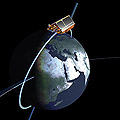|
The Arctic Ocean is a
challenging region for tidal modelling, because
of its complex and poorly documented bathymetry, combined together with
the intermittent presence of sea ice.
In addition, at such high latitude, in-situ tidal observations are
scarce and often not representative of the open ocean tide.
The accuracy of the global tidal models thus decreases by several
centimetres in Polar Regions, compared to other regions in the world
characterized by a strong tidal signal. This has a large impact on the
quality of the altimetry sea surface heights at high latitudes.
The activities under these CCNs included
- Assessment of the latest available Arctic bathymetry
datasets
- Generate an improved Arctic bathymetry by inverting
the
high resolution DTU15 gravity field derived from Cryosat-2 data, and
combining with the selected bathymetry
- Evaluate the new bathymetry through comparisons
against
available reference data, and assessments with the TUGO hydrodynamic
model.
- Using tidal constituents (with associated error
estimates)
derived from Cryosat-2 data, together with the TUGO hydrodynamic model,
develop and evaluate a new regional Arctic Tidal model for the Arctic
Ocean
A full description of the work is available in the CCN02 Final
Report
An ESA Web Story describing this work is available at
this link
|

